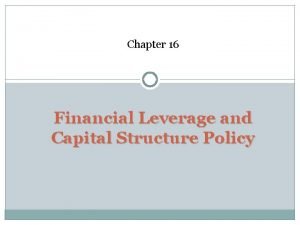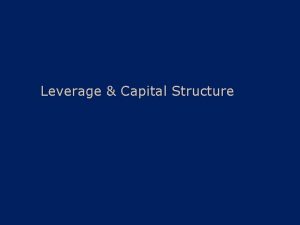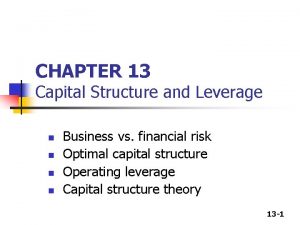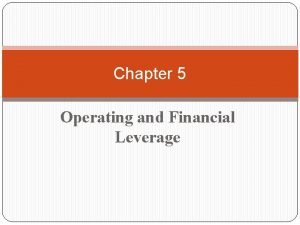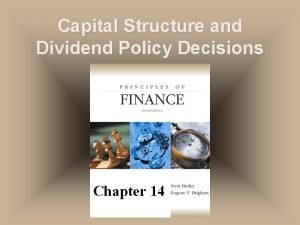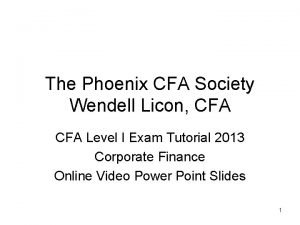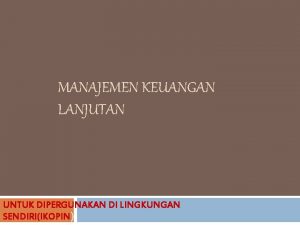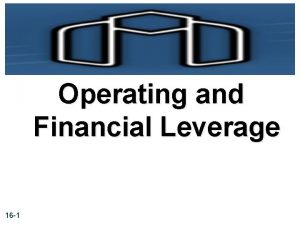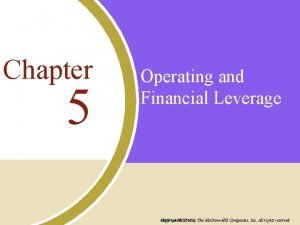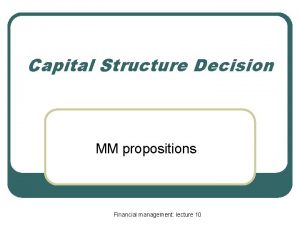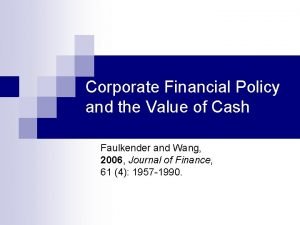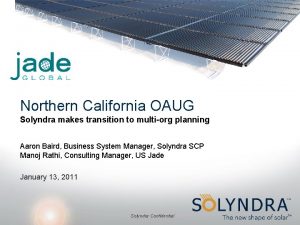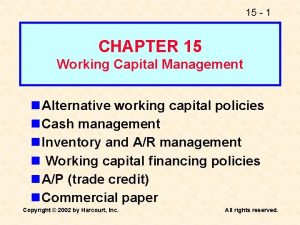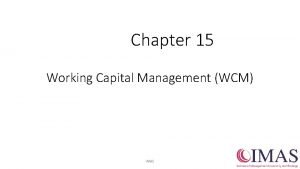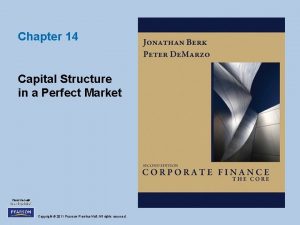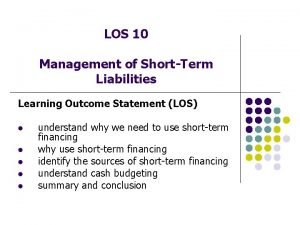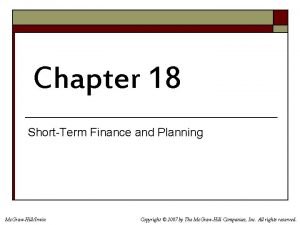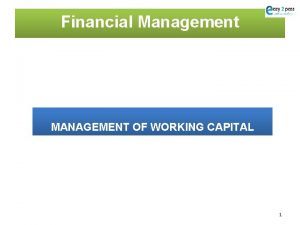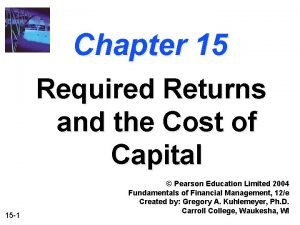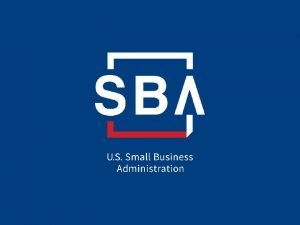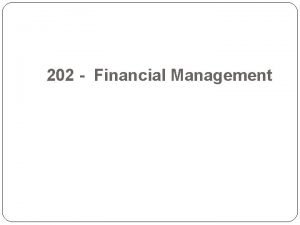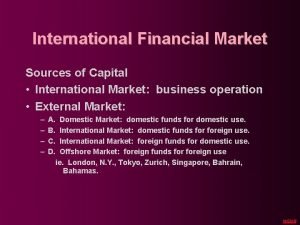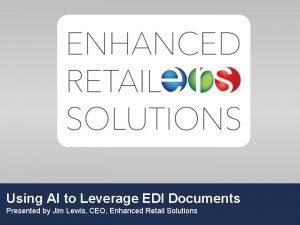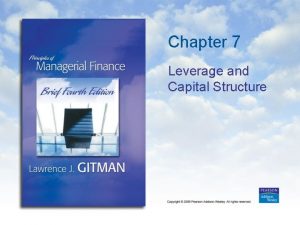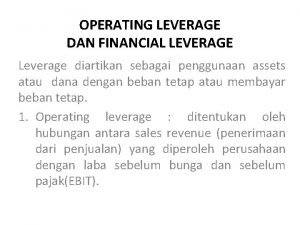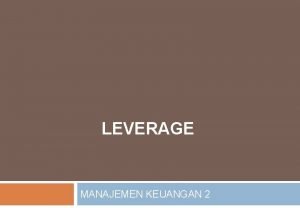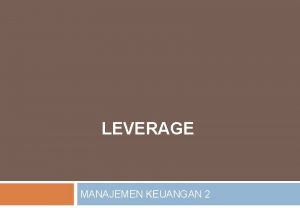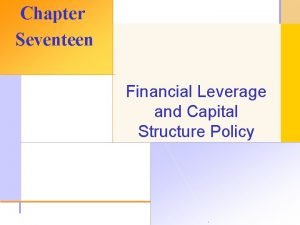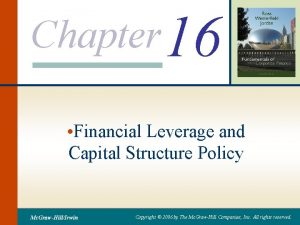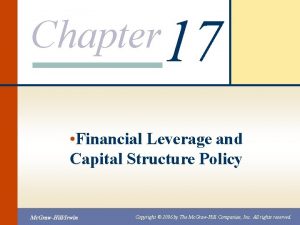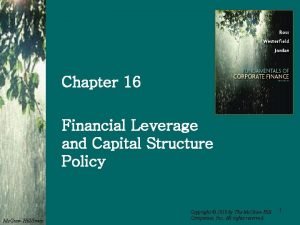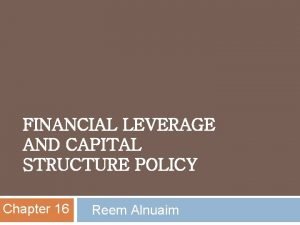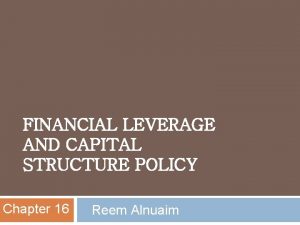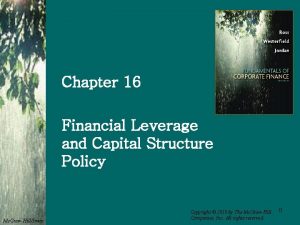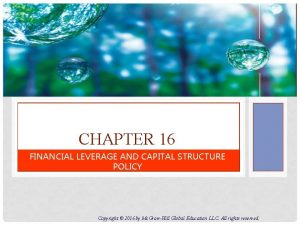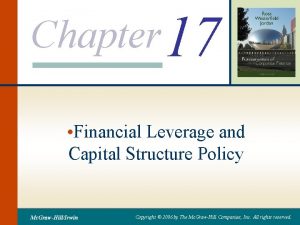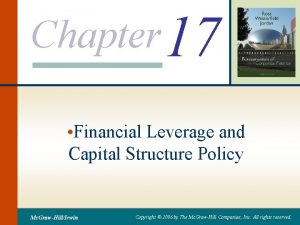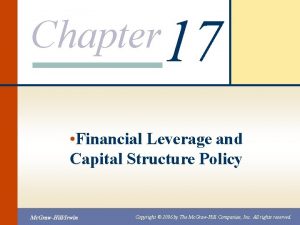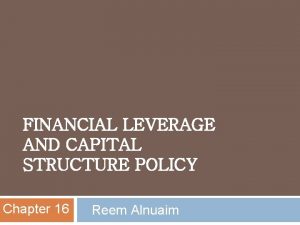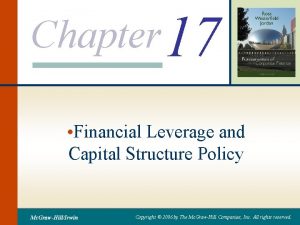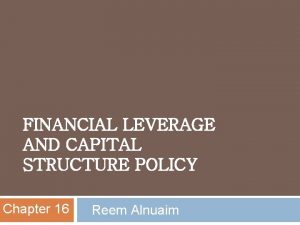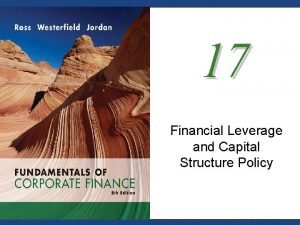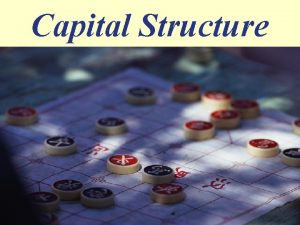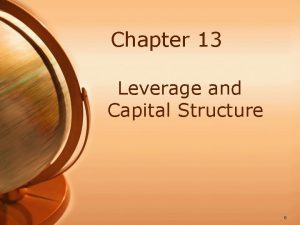Financial Leverage and Capital Structure Policy CHAPTER 16







































- Slides: 39

Financial Leverage and Capital Structure Policy CHAPTER 16

Capital Restructuring � What is meant by capital restructuring � What is the primary goal of financial managers? � Can leverage help in achieving such goals?

Capital Restructuring � We are going to look at how changes in capital structure affect the value of the firm, all else equal � Capital restructuring involves changing the amount of leverage a firm has without changing the firm’s assets � The firm can increase leverage by issuing debt and repurchasing outstanding shares � The firm can decrease leverage by issuing new shares and retiring outstanding debt

Choosing a Capital Structure � What is the primary goal of financial managers? Maximize stockholder wealth � We want to choose the capital structure that will maximize stockholder wealth � We can maximize stockholder wealth by maximizing the value of the firm or minimizing the WACC

Financial Leverage � The extent to which a firm relies on debt � The more debt financing a firm uses in its capital structure, the more financial leverage it employs

Financial leverage, EPS, and ROE: an example Review the example in word file CH 16 �

Break-Even EBIT � Find EBIT where EPS is the same under both the current and proposed capital structures � If we expect EBIT to be greater than the break-even point, then leverage is beneficial to our stockholders � If we expect EBIT to be less than the break-even point, then leverage is detrimental to our stockholders

Ex 1 Page 569 (SOLUTION IN WORD CH 16) � Maynard, Inc. , has no debt outstanding and a total market value of 250, 000$. EBIT are projected to be 28, 000$ if economic conditions are normal. If there is strong expansion in the economy, then EBIT will be 30 percent higher. If there is a recession, then EBIT will be 50 percent lower. Maynard is considering a 90, 000$ debt issue with a 7 percent interest rate. The proceeds will be used to repurchase a share of stock. There are currently 5, 000 shares outstanding. Ignore taxes for this problem A. Calculate EPS under each of the three economic scenarios before any debt is issued. Also calculate the percentage changes in EPS when the economy expands or enters a recession. B. Repeat part (a) assuming that the economy goes with recapitalization. What do you observe?

Ex 4 Page 542 � James Corporation is comparing two different capital structures: an all equity plan (plan I) and a levered plan (plan II). Under plan I, the company would have 160, 000 shares of stock outstanding. Under plan II, there would be 80, 000 shares of stock outstanding and 2. 8$ million in debt outstanding. The interest rate on the debt is 8 percent and there are no taxes. A. If EBIT is 350, 000$, which plan will result in the higher EPS? B. If EBIT is 500, 000$, which plan will result in the higher EPS? C. What is the break-even EBIT?

Corporate borrowing & home made leverage 1. The effect of leverage depends on the company’s EBIT. When EBIT is relatively high, leverage is beneficial 2. Under the expected scenarios, leverage increase the returns to shareholders, as measured by both ROE and EPS 3. Shareholders are exposed to more risk under the proposed capital structure because the EPS and ROE are much more sensitive to changes in EBIT in this case 4. Because of the impact that financial leverage has on both the expected return to stockholder and the riskiness of the stock, capital structure is an important consideration

Corporate borrowing & home made leverage � Homemade leverage: the use of personal borrowing to change the overall amount of financial leverage to which the individual is exposed. � REVIEW THE WORD CH 16 EXAMPLE ON HOMEMADE LEVERAGE.

Corporate borrowing & home made leverage Proposed capital structure recession expected expansion EPS 0. 5$ 3$ 5. 5$ Earnings for 100 shares 50 300 550 Original capital structure and homemade leverage EPS 1. 25 2. 5 3. 75 Earnings for 200 shares 250 500 750 Less: interest on $2, 000 at 10% 200 200 Net earnings 50 300 550

Ex 9 Page 543 � ABC Co. and XYZ Co. are identical firms in all respects except for their capital structure. ABC is all equity financed with 600, 000$ in stock. XYZ uses both stock and perpetual debt; its stock is worth 300, 000$ and the interest rate on its debt is 8 percent. Both firms expect EBIT to be 80, 000$ A. Rico owns 30, 000$ worth of XYZ’s stock. What rate of return is he expecting? B. Show Rico could generate exactly the same cash flows and rate of return by investing in ABC and using homemade leverage?

Capital Structure Theory � Modigliani and Miller (M&M)Theory of Capital Structure Proposition I (no taxes): the value of the firm is independent of the firm’s capital structure The value of the firm is NOT affected by changes in the capital structure. Which means the value of a levered firm (VL) is equal to the unlevered firm VU (VL=VU) The cash flows of the firm do not change; therefore, value doesn’t change (THE PIE MODEL) A firm’s WACC is the same no matter what mixture of debt and equity is used to finance the firm.

Capital Structure Theory We want to see what happens when we the debt equity ratio in a firm is changed (ignoring taxes). • Since WACC = required rate of return on firms assets WACC =RA. And when we put RE in one side we will have: RE = RA + (RA – RD)(D/E) We know as a fact that the cost of debt is lower than the cost of equity. However, this change is offset by the increase in the cost of equity from borrowing.

� Proposition II (no tax) RE = RA + (RA – RD)(D/E) The firm’s cost of equity capital is a positive linear function of the firm’s capital structure The cost of equity depends on three things: WACC or RA, cost of debt, and D/E debt equity ratio. Implications II � The cost of equity rises as the firm increases its use of debt financing. The risk of equity depends on two things: A. the riskiness of the firm’s operations(Business risk)and this risk determines RA. B. financial risk and it is determined by D/E.

Capital Structure Theory

Example Required return on assets = 16%(same as WACC=16%) cost of debt = 10%; debt=45% (tax is ignored) � What is the cost of equity? RE = RA + (RA – RD)(D/E) = 0. 16 + (0. 16 -0. 10)(45/55) Re = 20. 9% � Suppose instead that the cost of equity is 22%, what is the debt-to-equity ratio? RE = RA + (RA – RD)(D/E) 0. 22= 0. 16 + 0. 06 (D/E) 0. 22 -0. 16 = 0. 06 (D/E) 0. 06 = 0. 06 (D/E) D/E = 1 � Based on this information, what is the percent of equity in the firm? 50%

M & M proposition I and II with corporate taxes Example page 547 Firm U Firm L EBIT 1, 000 I 0 80 Taxable income 1, 000 920 Taxes (30%) 300 276 NI 700 644

M & M proposition I and II with corporate taxes CFFA Firm U Firm L EBIT 1, ooo Taxes 300 276 total 700 724 We see from the result that capital structure has some effect because the cash flow from U and L is not the same, even thought the two firms have identical assets. Cash flow Firm U Firm L To stock holder 700 644 To bond holder 0 80 total 700 724 The fact that interest is deductible for tax purposes has generated a tax saving = interest payment ($80) * tax rate (0. 30) = $24 = interest tax shield

M & M proposition I and II with corporate taxes � Interest is tax deductible � Therefore, when a firm adds debt, it reduces taxes, all else equal � The reduction in taxes increases the cash flow of the firm � How should an increase in cash flows affect the value of the firm?

M & M proposition I with taxes

M & M proposition I and II with corporate taxes � Debt has two features that we haven’t talked about in M&M Proposition I& II (with tax ignored): 1. interest paid on debt is tax deductible. (good for a firm) 2. failure to meet debt obligations can result in bankruptcy. (not good for a firm). � Interest tax shield: the tax saving attained by a firm from interest expense � Proposition I with taxes: � Value of a levered firm = value of an unlevered firm + PV of interest tax shield � VL = VU + DTC (page 548) � Implications of proposition I: 1. Debt financing is highly advantageous. 2. A firm WACC decreases as the firm realize more heavily on debt financing

Example � EBIT = 25 million; Tax rate = 35%; Debt = $75 million; Cost of debt = 9%; Unlevered cost of capital = 12% � Calculate the PV of VU, VL? VU = EBIT * (1 - Tc)/ RU = 25, 000*(1 -0. 35)/ 0. 12 = 135, 416, 666. 7 The value of levered firm = VL= VU+ Tc*D = 135, 416, 666. 7 + (0. 35*75, 000)= 161, 666. 7

M&M proposition II with tax Proposition II with tax: � RE = RU+ (RU-RD) (D/E) (1 -Tc) RU= unlevered cost of capital or cost of capital of firm with no debt. Implications of proposition II (with tax): cost of equity rises as the firm increases its use of debt financing. The risk of equity depends on two things: A. the riskiness of the firm’s operations(Business risk)and this risk determines RA. B. financial risk and it is determined by D/E.

Proposition II with taxes

Ex 10 Page 571 � Wood Crop. Uses no debt. The WACC is 9 percent. If the current market value of the equity is 23$ million and there are no taxes, what is EBIT? With no taxes, the cost of capital of unlevered firm is the cost of equity which can be used as a discount rate for the firm’s value. VU = EBIT/WACC $23, 000 = EBIT/0. 09 EBIT= 0. 09 ($23, 000) EBIT= $2, 070, 000

Ex 11 Page 543 � In the previous question suppose that corporate tax rate is 35 percent. What is EBIT? What is the WACC? Explain? If there are corporate taxes, the value of unlevered firm is: VU= EBIT (1 -tc)/ RU EBIT: $23, 000 = EBIT (1 -. 35)/0. 09 EBIT= $3, 184, 615. 38 WACC = still the same 9%

Ex 14 Page 543 � Frederick & Co. expects its EBIT to be 92, 000$ every year for ever. The firm can borrow at 9 percent. Frederick currently has no debt, and its cost of equity is 15 percent. If the tax rate is 35 percent, what is the value of the firm? What will the value be if the company borrows 60, 000$ and uses the proceeds to repurchase shares? The value of the unlevered firm is: VU = EBIT(1 – t. C)/RU VU = $92, 000(1 –. 35)/. 15 VU = $398, 666. 67 The value of the levered firm is: . b VL = VU + t. CD VL = $398, 666. 67 +. 35($60, 000) VL = $419, 666. 67

Ex 15 Page 544 � In problem 14, what is the cost of equity after recapitalization? What is the WACC? What are the implications for the firm’s capital structure decision? We can find the cost of equity using M&M Proposition II with taxes. Doing so, we find: RE = RU + (RU – RD)(D/E)(1 – t) RE =. 15 + (. 15 –. 09)($60, 000/$398, 667)(1 –. 35) RE =. 1565 or 15. 65% Using this cost of equity, the WACC for the firm after recapitalization is: WACC = (E/V)RE + (D/V)RD(1 – t. C) WACC =. 1565($398, 667/$419, 667) +. 09(1 –. 35)($60, 000/$419, 667) WACC =. 1425 or 14. 25%

Bankruptcy Costs �Direct costs Legal and administrative costs Ultimately cause bondholders to incur additional losses Disincentive to debt financing �Financial distress Significant problems in meeting debt obligations Firms that experience financial distress do not necessarily file for bankruptcy

Bankruptcy Costs � Indirect bankruptcy costs Indirect cost are more difficult to measure and estimate Stockholders want to avoid a formal bankruptcy filing Bondholders want to keep existing assets intact so they can at least receive that money Assets lose value as management spends time worrying about avoiding bankruptcy instead of running the business The firm may also lose sales, experience interrupted operations and lose valuable employees

Optimal Capital Structure Static theory of capital structure � This theory says that firms borrow up to the point where the tax benefit from an extra dollar in debt is exactly equal to the cost that comes from the increased probability of financial distress. Illustration to the next figure of the value of the firm First line (yellow), represent M&M proposition I with No tax (straight line) Next line (blue), represent M&M proposition I with tax. (Upward slopping straight line) Third line (red), represent the static theory of capital structure or the optimal capital structure(the value of the firm rises to a maximum and then decline beyond that point. At the maximum value of the firm VL* is reached at D* which means the optimal amount of borrowing. The difference between the value of the firm in static theory and M&M value of the firm with tax is the loss in value from the possibility of financial distress

Optimal Capital Structure � The static theory of capital structure:

Optimal Capital Structure We know that the capital structure that maximizes the � value of the firm is the one that minimize the cost of capital. Next figure represent the WACC line which � correspond to the static theory. Decline at first because the after tax cost of debt is cheaper than o cost of equity. However, at some point the cost of debt begins to rise, and the o fact that debt is cheaper than equity is offset by the financial distress cost. Minimum WACC occurs at D/E*. o

Optimal Capital Structure and the cost of capital


Conclusions � Case I – no taxes or bankruptcy costs No optimal capital structure The value of the firm and its WACC are not affected by capital structure. � Case II – corporate taxes but no bankruptcy costs Optimal capital structure is almost 100% debt Each additional dollar of debt increases the cash flow of the firm WACC decreases as much as the amount of debt goes up. � Case III – corporate taxes and bankruptcy costs Optimal capital structure is part debt and part equity Occurs where the benefit from an additional dollar of debt is just offset by the increase in expected bankruptcy costs

Managerial recommendations � Taxes o The tax benefit from leverage is important only to firm that are in a tax paying position. o Firm with accumulated losses will get little value from the interest tax shield. o The higher the tax rate, the greater the incentive to borrow. � Financial distress o the greater the volatility in EBIT, the less a firm should borrow. In other words, firms with greater risk of experiencing financial distress, will borrow less than other firms.
 Financial leverage and capital structure policy
Financial leverage and capital structure policy Degree of total leverage
Degree of total leverage Operating leverage formula
Operating leverage formula Chapter 13 leverage and capital structure gitman ppt
Chapter 13 leverage and capital structure gitman ppt Operating and financial leverage chapter 5
Operating and financial leverage chapter 5 Business vs financial risk
Business vs financial risk Types of dividend policy
Types of dividend policy Multinational capital structure
Multinational capital structure Multinational cost of capital and capital structure
Multinational cost of capital and capital structure Wacc formule
Wacc formule Rumus dcl
Rumus dcl Floatation cost
Floatation cost Operating financial leverage
Operating financial leverage Financial leverage deals with
Financial leverage deals with M&m propositions
M&m propositions Working capital requirement
Working capital requirement Difference between capital reserve and reserve capital
Difference between capital reserve and reserve capital Difference between capital reserve and reserve capital
Difference between capital reserve and reserve capital Constant vs variable capital
Constant vs variable capital Corporate financial policy and the value of cash
Corporate financial policy and the value of cash Capital markets and financial intermediation
Capital markets and financial intermediation Financial markets and the allocation of capital
Financial markets and the allocation of capital Lift and leverage
Lift and leverage Working capital financing policy
Working capital financing policy Maturity matching working capital financing policy
Maturity matching working capital financing policy Capital structure in a perfect market
Capital structure in a perfect market Basle ii
Basle ii Regulatory capital vs economic capital
Regulatory capital vs economic capital Capital allocation line vs capital market line
Capital allocation line vs capital market line Non financial motivators
Non financial motivators A flexible short term financial policy
A flexible short term financial policy A flexible short term financial policy
A flexible short term financial policy Dividend policy decision in financial management
Dividend policy decision in financial management Dividend policy decision in financial management
Dividend policy decision in financial management Long term financing
Long term financing Cost of capital in financial management
Cost of capital in financial management Capital access financial system login
Capital access financial system login What is working capital in financial management
What is working capital in financial management Capital international financial
Capital international financial How to leverage edi
How to leverage edi
